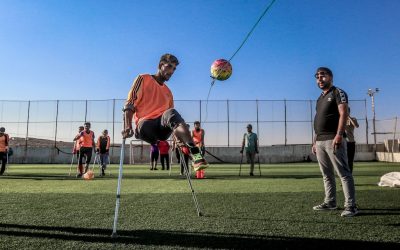MOVING EARTH
The Environmental Physiotherapy Association Blog features regular news, events and ideas on all things Environmental Physiotherapy.
The contributions presented in this blog do not necessarily represent the opinions and values of the Environmental Physiotherapy Association as such. Rather, they represent the thoughts and work of contributing authors and through these, an open and ongoing discussion of what an environmentally aware and responsible is, could and should be.
Please use our contact form if you are interested in contributing to Moving Earth: The Environmental Physiotherapy Association Blog. Contributions in any language and any format on all potentially related topics welcome! Please see our contribution guidelines at the bottom of this page. We appreciate your help in developing and advancing an environmentally aware and responsible physiotherapy profession across research, education and clinical practice.
Access to clean and healthy environments is now a universal human right
The United Nations (UN) declared access to clean and healthy environments a universal human right in July 2022. This historic decision was voted in...
Showcasing the Potential of Student Research at the Fourth Environmental Physiotherapy Roundtable
For the fourth year in a row, toward the end of November each year since the launch of the EPA, we have hosted an environmental physiotherapy...
Sustainability in orthopaedic physiotherapy and rehabilitation
With the goal of decarbonization and carbon neutrality in the health sectors of many countries by 2050, health professionals must implement systemic...
An evidence-based guide for decarbonizing physiotherapy clinics
Climate change is the largest threat to human health and wellbeing globally (WHO, 2021). The healthcare industry itself currently contributes to...
Nature as co-therapist: Physiosail and the connection between disability and environment
The definition of disability and disabled people depends on the model used. The most widely used model in the health system is the "medical model"....
Refocusing Disablement Models about Context: Physiotherapy and the Ecological-Enactive Model of Disability
A complete, humanized description of disability requires consideration of context (e.g., physical environment, social interactions, background...
Occupational Therapists for Environmental Action
The Occupational Therapists for Environmental Action (OTEA) is an American network of occupational therapy (OT) practitioners, researchers,...
Environmental physiotherapy and ENPHE The European Network of Physiotherapy in Higher Education
Exciting news seem a near regularity in environmental physiotherapy now. And why not. With so much that still needs doing, we need them very much....
Breaking up the boundaries of our profession and creating something meaningful – Living the Oneness of One Health
Things are packed, and the passport is ready. Now it's just a matter of getting on the train and embarking on an adventure. Quite unexpectedly, as a...
How do you touch an impossible thing?
Here’s a question to ponder: When you think about the physical therapies — touch, movement, exercise, electrotherapy, hydrotherapy, and so on — do...
Environmental Physiotherapy Education Podcast
Environmental Physiotherapy on youtube
Moving Earth – Guidelines for blogposts:
Text, video, audio, image and other types of contributions in any language are all welcome.
If you contribute a text, we will need the following:
- text 250-1000 words to be sent in a word doc. The text cannot contain numbered/bullet point lists.
- 3-5 jpg images (horizontal alignment, high resolution, either from your private collection or licensed as ‘free to share and use’, sent as individual email attachments). Please send images as separate files, rather than contained with the word document
- use of references is possible, but not mandatory (always depends on your topic). If you use references, please do so using APA7th.
- a declaration clearly stating if and how AI was used in the creation of your blogpost
Regardless of contribution type, for the author info box, please also send us
- profile picture of yourself
- your current title and role
- max 40 word (2 sentences) text about yourself (check existing blogposts for some examples)
- your Linkedin handle (if you have one; alternatively a website through which people can find how to contact you)
We appreciate your effort and support in developing and advancing environmental physiotherapy in all of its facets, and look forward to reviewing your draft contribution!










